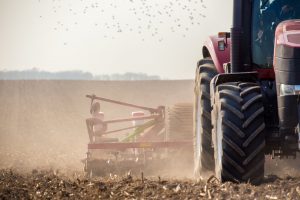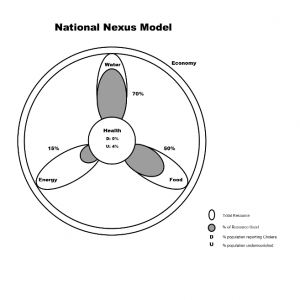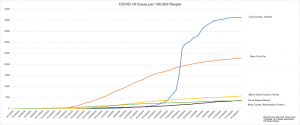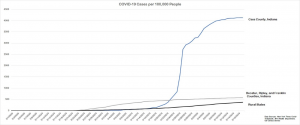
Societal sustainability rests on the three interconnected pillars of water, energy and food, the WEF Nexus. Supply and demand of each must be in balance with the other two or the three-legged stool either wobbles or falls over leading to social and political instability. The ultimate driver of the Nexus is economics, and WEF interactions control health of the population. In most analyses, urban and rural communities are combined to develop societal or national Nexus models, but there is a major disconnect between rural supplies and urban consumption that progressively widens as populations urbanize. The COVID-19 pandemic has brought this into sharp focus for the first time. The least understood component of the Nexus is health and its feedback loops to economics through water, energy and food. Decisions on managing COVID-19 must not be based solely on either economics or health while ignoring the WEF and its interactions with both.

URBAN-RURAL DISCONNECT
From the beginning of the pandemic, large metropolitan areas were the focus of all discussion because of population density, poverty and hygiene concerns, a lack of personal space and their position as international transportation hubs. Well into April 2020, President Trump and many governors stressed that COVID-19 was a problem of large, crowded and poor urban areas, while rural states had little to fear because population was low, dispersed and far from pandemic centers. That mantra soon faded as the virus spread into suburban areas of higher income and even into Heartland rural areas far from virus hotspots during the first three weeks of April. It simply took longer for the virus to reach those areas.
Populations of rural areas of the Midwest are often dominated by extended families of the original settlers, whose children stayed on the farm, and interactions with urban areas were mainly for marketing agricultural products. Demographics began to change after WWII as children left for universities and employment in urban centers leaving a labor gap that increasingly was filed by migrant farmworkers from Mexico. Processing of crops and livestock was centered in large metropolitan areas like Minneapolis and Chicago, immortalized in the poem of Carl Sandburg in 1914 as “hog butcher for the world.” Rural areas simply supplied the demand of urban populations.
Beginning in the late 1960s and expanding rapidly to the present, food processing operations relocated closer to their product suppliers in rural areas. Faced with a labor shortage due to emigration of local youth to urban centers, agriculture industries began to fill the gap with Mexicans initially and increasingly recruited Central Americans and Southeast Asians. Still, local populations from an expanded geographic area sought employment at such factories to supplement decreasing income from their family farms. Industrial expansion into the Heartland was also attractive to the automotive industry lured by cheap land and a pool of educated local workers.
Upton Sinclair in The Jungle (1906) chronicled in graphic detail the cramped and unsanitary working and living conditions of recent immigrants laboring in the meat processing stockyards and plants in Chicago, which were linked to a tuberculosis outbreak and ultimately provided the stimulus for President Theodore Roosevelt to push for adoption of the Meat Inspection Act and Pure Food and Drug Act by Congress. Although sanitation was greatly improved thereafter, crowded working and living conditions for immigrant labor were still evident as meat processing plants began moving to rural areas in the 1970s.
COVID-19 ARRIVES IN THE HEARTLAND
COVID-19 was delayed in moving into rural America. On March 29, approximately 80% of documented cases were in urban core areas. But by April 12, the distribution had changed significantly with only 31% urban, and a clear spread into suburban (45%) and small towns/rural areas (24%). What started out as mostly a white problem in suburbs increasingly included Hispanics and African Americans as the virus spread into the Midwest and Black-dominated counties of the South.
The initial reasoning that rural counties were in little danger from the virus was based on their low population densities and relative isolation. However, such areas tend to have long established populations with strong social networking through their large extended families and churches. We selected six states (Idaho, Iowa, Kansas, Mississippi, Montana, Nebraska, North Dakota, South Dakota) to represent “rural states” because they lack major metropolitan areas and are heavily dependent on agriculture. While COVID-19 cases began to increase in New York City and Seattle on March 20 and Miami on March 27, the subset of rural states displayed steady but slow growth in COVID-19 starting about April 16 and reached the level of Seattle by May 16, the end of our study.
There were a few virus hotspots in rural states beginning in mid-April, including two in Indiana. From the first reported case at the end of March, COVID-19 per capita cases in my childhood home of Logansport, Cass County, Indiana began increasing exponentially on April 20, exceeding New York City on April 25. Reported cases in Cass County peaked on May 11 and remained at approximately 4,100 per 100,000 residents through the end of our reporting period on May 16. In contrast, cases in New York City continued to increase somewhat after Cass County stabilized at approximately double the per capita rate of New York.

The trend of virus spread was vastly different in the second Indiana hotspot. COVID-19 first appeared in Decatur, Franklin and Ripley Counties of southeastern Indiana (total population 78,000) in the third week of March and increased steadily, reaching 500 cases/100,000 residents on April 23, after which it remained steady through at least May 16. The prime employer in this 97% white region is Honda (2,500 workers), which ceased operation on March 23 in response to reports of virus spread into rural areas. The source of the virus is not clear, but suggested sources include family members working in the Honda plant and urban areas, students returning home from school, and truck stops along I-74, the main route between Cincinnati and Indianapolis. By the end of our study on May 16, virus cases/100,000 in southeastern Indiana were within the range reported for our subset of six rural states (500 versus 400).
In contrast, Logansport, Cass County, in north central Indiana has a much smaller (38,000) and more diverse (88% white, 12% Hispanic) population whose largest employer (2,200) is a Tyson meat packing facility. The first confirmed COVID-19 case in Cass County was at the end of March and ultimately traced to a Tyson employee. The company began implementing protective measures for its employees in early March and ultimately ceased operation on April 22, when confirmed cases in the county reached 87. By the end of April, 890 of 1200 cases in Cass County were attributed to Tyson employees.
While the steepness of the curve at the end of April is strongly associated with testing of all Tyson employees, the underlying importance of close quarter working and living conditions must be addressed. Many of the Tyson workers are recent immigrants from Latin America and Southeast Asia, who live in close quarters out of economic necessity with people working at several meat processing facilities. Once the virus gets into such a house, it can quickly spread to two other meat plants within 30-minute drives from Logansport.

COVID-19 IMPACTS ON AGRICULTURAL PRODUCTION AND FOOD AVAILABILITY
Closure of restaurants, schools and hotels during March, coupled with increased COVID-19 cases among workers in the agriculture sector, had an immediate impact on the supply of meat, milk, eggs and fresh produce. As demonstrated for Cass County, Indiana, meat plants were especially hard hit with the virus, leading to closure of large operations in North Dakota, South Dakota, Iowa, Indiana and elsewhere, with the 15 largest plants accounting for 60% of US pork. Tyson Foods published a whole page ad in the New York Times stating, “the food supply chain is breaking.” Currently, approximately 5% of milk is being dumped because of the market loss of schools, and egg production has also crashed as plants close including one in Nebraska serving 10% of egg market.
The food service sector is responsible for half of all food dollars spent in the United States, including 40% of fresh produce and 80% of Florida tomatoes. The pandemic also has reduced demand for Florida cucumbers, cabbage and lettuce by almost 100%. Farmers have either let perishable crops rot in fields or plowed them under to discourage pests. Florida farmers are faced with a major dilemma; while recognizing there will be a major income loss this year, they must now decide on whether or not to plant this Spring. What course COVID-19 takes in the US will determine if there will be a market for the new crops. Many Florida farmers are struggling with whether to endure financial losses in the face of an even bigger problem as the country faces a continuing food shortage.
SEPARATE MARKETS AND SUPPLY CHAINS
The United States has plenty of food but cannot get it where needed most. Because of complete separation of commercial and residential supply chains, there is no mechanism for redirecting food to where needed most during the pandemic, residential and food banks. Cross-sector relationships and contracts are weak or non-existent, there are limited storage facilities for short shelf life items like vegetables, meat and dairy, and suppliers lack the right packaging to accommodate the commercial market. They are accustomed to selling in bulk, not consumer size portions. Food banks are suffering serious shortages because most have limited contact with suppliers and can not accept large shipments of perishable products. Even if relationships among supply chains could be established, the pandemic has crippled transport because of a reduced labor force. The bottom line, food rots in fields or is dumped.
The USDA historically has been a lifeline for excess food, especially for canned products with long shelf life. They are not accustomed to dealing with fresh, perishable items. The agency in mid-April 2020 announced its intent to purchase $3 billion in excess food including $100 million per month for six months for fresh fruits, vegetables, dairy and cooked meat. These items would then be sorted into variety boxes for distribution where needed. Details have not been forthcoming, and the program is likely to face many hurdles associated with storage and distribution.
LABOR FORCE IS CRITICAL
Meat, egg and milk production relies heavily on immigrant labor, and perishable vegetables and seasonal fruits farmers must have large numbers of migrant workers at peak harvest times. Workers often live in cramped camps with poor hygiene and no social distancing, are transported to and from fields in crowded buses and work in close proximity with one another during harvest. Many feel compelled to continue working even if sick for fear of losing their jobs. Such conditions are favorable for COVID-19 spread. Already farmers are experiencing labor shortages from disease, and the constant fear of deportation has led many to return to their native countries, where loss of cash remittances from the United States is causing major economic hardships.
Immigrants are a major component of the total agriculture workforce of the United States (50%, 33% of meat processing) and even more so globally. Spain needs 30,000 seasonal workers (85% foreigners) to harvest cherries, nectarines, peaches and apricots. Of the 16,000 Moroccans needed to harvest fruit in Huelva, only half arrived. Spanish labor needed for vegetable harvesting is equally dependent on foreign workers (18,000 in May and 28,000 in June). Food is left to rot in fields of the United Kingdom because of a shortage of 70-80,000 migrant workers, only a fraction of the labor need being filled by residents (35,000), which has prompted Prince Charles and others to appeal to college students and furloughed workers to volunteer to help with the harvest. Traditionally, seasonal, self-employed and informal resident workers in Italy and Greece were extremely important for agricultural productivity, but national lockdowns have been devastating to them. Most have limited or no access to government assistance programs as seen in Italy where they are difficult to identify and track because they either do not pay or contribute little to the tax base.
While resident farm workers often rely on support from their families and communities during lockdowns, migrant and immigrant workers do not have such an option. Perhaps the worst case are the “invisibles,” undocumented African migrants in Italy who were day laborers but now are locked down with no support system. In Castel Volturno north of Naples, 47 West African men were documented living in a house with broken windows, no electricity or water, and little food. Such conditions are perfect for COVID-19 spread and play a major role in the virus infection estimates of 10-20,000 in a population of 26,000. Government services have been slow to respond because the large immigrant population is under the control of organized crime. The migration of millions of day laborers from urban centers to their home villages as part of the total lockdown imposed in India is likely to have equally disastrous results from starvation, lack of social distancing and a weak social welfare system.
Recognizing that closure of international borders, illness and deportation have resulted in an inability to replace lost farm workers, the United States and several European nations including Greece, Italy and Spain have declared farmworkers (both foreign and domestic) as essential workers. By Royal decree, Spain will allow 100-150,000 undocumented and unemployed people to harvest crops, and Italy, faced with unions and non-profits calling for general amnesty to legalize undocumented migrants, is considering an express law to allow 200,000 migrants to serve as day laborers for up to a year.
FINAL THOUGHTS
The Nexus of water, energy and food is a flexible framework to assess societal and ecosystem sustainability that recognizes both the importance of economics as the overarching control over resources and allocations, and their impact on health. The weakest link in the Nexus is the role of health. The COVID-19 pandemic has drastically changed how the WEF influences sustainability in two fundamental aspects. First, health is no longer considered a passive recipient of economic and WEF interactions, but can replace economics as the ultimate driver of the Nexus, and second, policy based on economics and health in an either-or scenario without incorporating WEF is doomed to failure.
Traditionally, rural communities have been viewed solely as suppliers of WEF resources for consumption in large urban communities. The urban-rural disconnect that has been expanding for decades as processers of agriculture products move closer to their supply source. Educated youth are leaving rural areas for training or careers in cities, and manufacturing, especially auto plants, are moving to rural areas because of cheap land and economic incentives plus a pool of underemployed, educated rural residents. The result has been a staggering shortage of farm laborers, which has been filled in the United States and Europe with migrants and immigrants. Border closures, deportation and virus spread within this population has highlighted the fragility of the supply chain of food for urban areas. Commercial and residential markets have collapsed, revealing an inability to change market sectors rapidly to meet changing demand.
The US Federal government has been slow to recognize the problem, waivered on stated positions and has failed to develop strategic policy to ensure societal sustainability in this and future pandemics. This is not the time to take a draconic approach to illegal immigrants. We need a system of work permits that allows entry of legal immigrants to work for set periods, while providing health care and affordable, safe housing.
What has changed in the past 100 years since publication of Upton Sinclair’s The Jungle? Meat processers have moved from urban to rural areas, the quality of meat products has improved, but immigrants still comprise a large percentage of workers, and both work and living conditions for them are still crowded and inadequate. Government closure of meat processing operations was appropriate, but re-opening plants before addressing worker health safety and the underlying causes for rapid spread of the virus in rural areas was totally unfounded. This was not an economic versus health issue isolated from the WEF. President Trump declared meat plants as critical infrastructure and used the Defense Production Act to order them to reopen. Production of meat was assured, but protection of meat and poultry workers was completely voluntary as part of this action.
The COVID-19 pandemic is not an isolated event in human history, but a harbinger of things to come. Jared Diamond, Michael Gregor and others have addressed emerging diseases and the evolution of human diseases from domestication of animals. Maximizing protein production to satisfy an exponentially increasing demand from developed and advancing nations has resulted in animal husbandry operations that reduce both the quality of life of animals and time for an ideal product. Once disease develops in such animal populations, it can easily spread through humans subjected to similar conditions in meat processing industries. We must focus on lessons of this pandemic to prepare for the next wave of emerging diseases.
*****
Dr. Thomas L. Crisman is Professor in the School of Geosciences at the University of South Florida and a U.S. State Department Jefferson Science Fellow. David Dumke is Director of the University of Central Florida’s Office of Global Perspectives & International Initiatives. Zachary S. Winters is a graduate student in School of Geosciences at University of South Florida.
This article was written as part of the Addressing Global Crisis Project (AGC), which is run by the University of Central Florida’s Office of Global Perspectives & International Initiatives (GPII). AGC examines how governments, individually and collectively, deal with pandemics, natural disasters, ecological challenges, and climate change. AGC is organized around five primary pillars: (1) delivery of services and infrastructure; (2) water-energy-food security; (2) governance and politics; (4) economic development; and, (5) national security. Through its global network, AGC facilitates expert discussion and features articles, publications and online content.